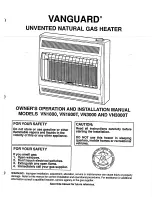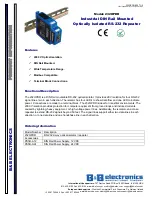
17
STS
-
JZ
-
F / IQ
-
F I&O Manual Z83.20
-
2016
IM101220
RD: APR 2019
RL: 20C
TABLE 4 COMBINED SYSTEM LENGTH: TUBE + AIR DUCT + VENT
Installations up to 4500 ft
-
Higher altitudes refer to Section 27
Example
150,000 Btuh Heater:
Tube Heater Length
50 ft
1 x 90° elbow (vent)
5 ft
Straight vent
20 ft
1 x 90° elbow (duct)
5 ft
Air Duct:
4”
Ø
17 ft
Combined Length
97 ft
Max. Allowed
100 ft
Additional 20’ for 5”
Ø Air Duct
High
Input Rate
(Btuh)
Do Not Exceed
Maximum Combined
System Length
Max. Air Duct
Length
(by Duct Diameter)
Max. Vent
Length
Individual:
4”
Ø
OR
Combined:
6”
Ø
from each
heater
Using
4”
Air
Duct
Using
5”
Air
Duct
4”
Ø
5”
Ø
45,000
& 60,000
60 ft
80 ft
20 ft
40 ft
20 ft
80,000
70 ft
90 ft
20 ft
40 ft
20 ft
110,000
to 150,000
100 ft
120 ft
30 ft
50 ft
30 ft
175,000
120 ft
140 ft
30 ft
50 ft
40 ft
200,000
-
130 ft
Use
5”
Ø
30 ft
40 ft
HEATER EXPANSION AND VENT CONFIGURATION
A radiant tube heater will expand and contract as it heats and cools. Configuration of the vent must
allow for heater expansion.
VERTICAL VENT
: Orientation of the vent at 90° to heater will allow for heater expansion and
contraction.
HORIZONTAL VENT
: (See FIG. 4)
◼
Wall Thimble or flashing at wall
that allows movement of the vent
through the opening. Do not seal
the vent to the thimble or flashing
with caulking.
OR
◼
Offset vent with two x 90° elbows.
Install minimum 12 inch [305 mm]
length of straight vent between
elbows. Vent can be sealed with
caulking at non
-
combustible wall.
◼
Other means of slip fit installation
of the vent are acceptable provid-
ing there is adequate allowance
for free expansion and contraction
of the system, and free flow of
vent gases.
FIGURE 4: ALLOW FOR HEATER EXPANSION
-
HORIZONTAL VENT
-
TOP VIEW
COMMON VENTING
For vertical vent only, two heaters can be commonly vented using
4”
x
6”
x
4”
Vent Tee JA
-
0514
-
XX.
Both heaters must be operated using one common thermostat. Common vent is 6 inch
[150 mm]
di-
ameter.
Category III (horizontal vent) heaters cannot be common vented.
















































